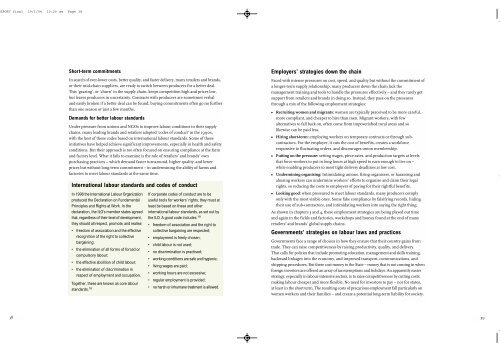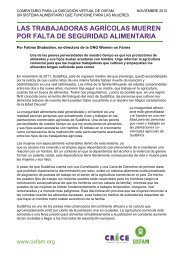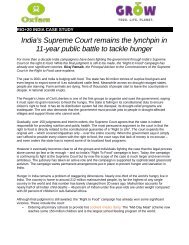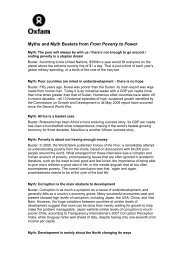Trading Away Our Rights - Oxfam International
Trading Away Our Rights - Oxfam International
Trading Away Our Rights - Oxfam International
Create successful ePaper yourself
Turn your PDF publications into a flip-book with our unique Google optimized e-Paper software.
EPORT final 19/1/04 10:20 am Page 38Short-term commitmentsIn search of ever-lower costs, better quality, and faster delivery, many retailers and brands,or their mid-chain suppliers, are ready to switch between producers for a better deal.This ‘grazing’, or ‘churn’ in the supply chain, keeps competition high and prices low,but leaves producers in uncertainty. Contracts with producers are sometimes verbaland easily broken if a better deal can be found; buying commitments often go no furtherthan one season or just a few months.Demands for better labour standardsUnder pressure from unions and NGOs to improve labour conditions in their supplychains, many leading brands and retailers adopted ‘codes of conduct’ in the 1990s,with the best of those codes based on international labour standards. Some of theseinitiatives have helped achieve significant improvements, especially in health and safetyconditions. But their approach is too often focused on ensuring compliance at the farmand factory level. What it fails to examine is the role of retailers’ and brands’ ownpurchasing practices – which demand faster turnaround, higher quality, and lowerprices but without long-term commitment – in undermining the ability of farms andfactories to meet labour standards at the same time.<strong>International</strong> labour standards and codes of conductIn 1998 the <strong>International</strong> Labour Organizationproduced the Declaration on FundamentalPrinciples and <strong>Rights</strong> at Work. In thedeclaration, the ILO’s member states agreedthat, regardless of their level of development,they should all respect, promote, and realise:• freedom of association and the effectiverecognition of the right to collectivebargaining;• the elimination of all forms of forced orcompulsory labour;• the effective abolition of child labour;• the elimination of discrimination inrespect of employment and occupation.Together, these are known as core labourstandards. 18If corporate codes of conduct are to beuseful tools for workers’ rights, they must atleast be based on these and otherinternational labour standards, as set out bythe ILO. A good code includes: 19• freedom of association and the right tocollective bargaining are respected;• employment is freely chosen;• child labour is not used;• no discrimination is practised;• working conditions are safe and hygienic;• living wages are paid;• working hours are not excessive;• regular employment is provided;• no harsh or inhumane treatment is allowed.Employers’ strategies down the chainFaced with intense pressures on cost, speed, and quality but without the commitment ofa longer-term supply relationship, many producers down the chain lack themanagement training and tools to handle the pressures effectively – and they rarely getsupport from retailers and brands in doing so. Instead, they pass on the pressuresthrough a mix of the following employment strategies:• Recruiting women and migrants: women are typically perceived to be more careful,more compliant, and cheaper to hire than men. Migrant workers, with fewalternatives to fall back on, often come from impoverished rural areas and solikewise can be paid less.• Hiring short-term: employing workers on temporary contracts or through subcontractors.For the employer, it cuts the cost of benefits, creates a workforceresponsive to fluctuating orders, and discourages union membership.• Putting on the pressure: setting wages, piece-rates, and production targets at levelsthat force workers to put in long hours at high speed to earn enough to live on –while enabling producers to meet tight delivery deadlines at low cost.• Undermining organising: Intimidating unions, firing organisers, or harassing andabusing workers can undermine workers’ efforts to organise and claim their legalrights, so reducing the costs to employers of paying for their rightful benefits.• Looking good: when pressured to meet labour standards, many producers complyonly with the most visible ones. Some fake compliance by falsifying records, hidingtheir use of sub-contractors, and intimidating workers into saying the right thing.As shown in chapters 3 and 4, these employment strategies are being played out timeand again in the fields and factories, workshops and homes found at the end of manyretailers’ and brands’ global supply chains.Governments’ strategies on labour laws and practicesGovernments face a range of choices in how they ensure that their country gains fromtrade. They can raise competitiveness by raising productivity, quality, and delivery.That calls for policies that include promoting education, management and skills training,backward linkages into the economy, and improved transport, communications, andshipping procedures. But these cost money to the State – money that is not coming in whenforeign investors are offered an array of tax exemptions and holidays. An apparently easierstrategy, especially in labour-intensive sectors, is to raise competitiveness by cutting costs:making labour cheaper and more flexible. No need for investors to pay – nor for states,at least in the short term. The resulting costs of precarious employment fall particularly onwomen workers and their families – and create a potential long-term liability for society.3839
















